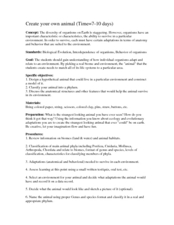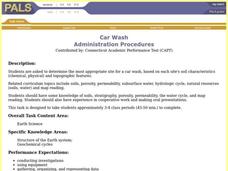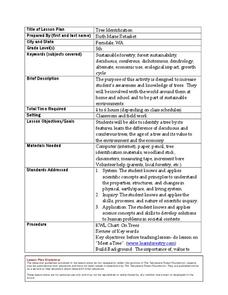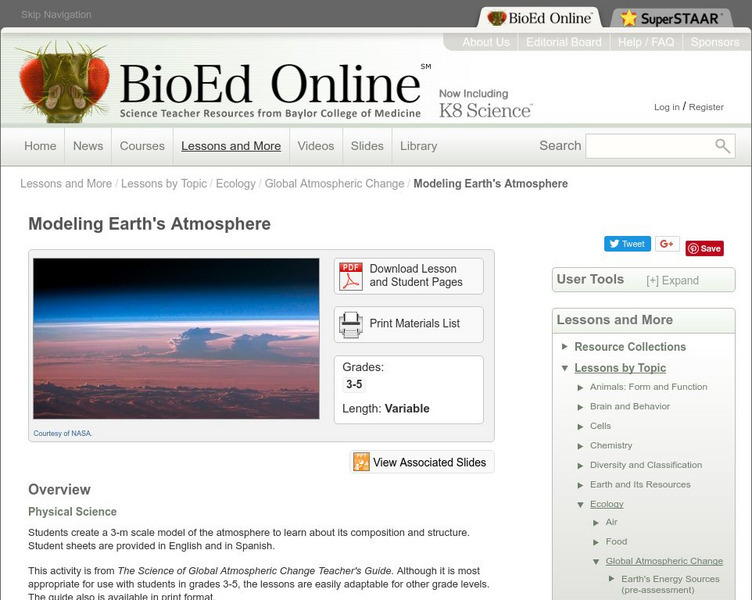Curated OER
Locating Vent Fields Using CTD Data
Students describe the way hydrothermal vents work. Students work on locating vent regions through remote collection of data about water temperature and density. Comparing density and temperatures graphs, students search for indicators...
Curated OER
The Phases of the Moon
Students observe the questions, "Why do we say there is a man on the moon?, What do you think of when you hear "the moon is made of cheese"?, What is meant, to you, by the expression "Once in a blue moon"? and a comic of Snoopy typing,...
Curated OER
A Global Water Crisis
Young scholars study the contamination of drinking water and what human activities play a role in it. In this environment lesson students complete worksheets and complete a lab activity.
Curated OER
Create Your Own Animal
Students design and create their own hypothetical animal. In this biology lesson, students identify the factors organisms need to survive. They classify their animals according to its correct phylum.
Curated OER
The Blizzard of 1993
Learners read and interpret the information from a barograph from a major winter storm. This task assesses students' abilities to interpret and analyze graphs, construct data tables and graphs, generalize, infer, apply knowledge of...
Curated OER
Formation of Wind
Students correctly sequence the steps leading to the formation of wind, and describe the cause and effect relationships involved in the formation of wind. This task assesses students' abilities to classify, generalize, infer, interpret...
Curated OER
Car Wash
Students determine the most appropriate site for a car wash, based on each site's soil characteristics (chemical, physical) and topographic features. They perform an experiment to determine the changes to three different soil types when...
Curated OER
Afghanistan and The Breadwinner
Pupils examine the use of the Hindu Kush mountains by explorers and traders. Using Afghanistan as an example, they research how different events can effect human settlerment patterns. They discuss how the physical characteristics of an...
Curated OER
Landscapes
Learners explore landforms and landscapes. They demonstrate an appreciation for and examine how to recognize the attributes of landforms and landscapes. Students create a landscape and reflect on their painting.
Curated OER
Weather and Seasons
Students look through pictures to examine the seasons and seasonal activities which include the Salish months and traditional activities for each month. They also discover why certain activities are done at the same time each year and...
Curated OER
Tree Identification
Learners list four ways to identify trees. In this tree identification instructional activity, students use tree identification techniques such as leafs, bark, wood grain, soil type, and climate to create tables and graphs.
Curated OER
Acid and Rain and Its Effects
Students work in groups for up to three weeks to investigate the possibility of acid rain in your area and to investigate the damage that acid rain can do to buildings, monuments, and plants. Each group prepares a report to local...
Curated OER
Measuring the Diameter of Our Star
Students conduct an experiment to measure the diameter of the sun. In this astronomy activity, students construct a simple equipment to collect scientific data. They calculate the sun's diameter using a given formula.
Curated OER
Changes Inside Planets
Students investigate the concept of planetary differentiation. They complete an experiment to simulate it using gelatin and food. The lesson includes vocabulary to increase reading comprehension skills as part of the inquiry. The lesson...
Curated OER
Eye From the Sky
Students are introduced to the concept of aerial perspective and scale. Students will use satellite technology to view their neighborhoods and sketch the area surrounding their schools. They will take part in a neighborhood walk to view...
Curated OER
Creating and Analyzing Graphs of Tropospheric Ozone
Students create and analyze graphs using archived atmospheric data to compare the ozone levels of selected regions around the world.
Curated OER
What is a Cloud
Third graders study clouds and how they are formed. They write acrostic poems about clouds and analyze and graph temperature data collected during varying degrees of cloud cover.
Curated OER
Adaptations To the Environment
Students design and construct an imaginary animal that is perfectly adapted to a particular type of biome. They give the animal a scientific name, place it in a phylum and write descriptions about its behavior, reproduction, foraging,...
Curated OER
Ions in the Environment
Students explain the importance of the five main biogeochemical cycles. In this chemistry lesson plan, students discuss how ions are transported in the environment. They design an experiment to collect data on eutrophication.
Curated OER
Physical Location; How a Border Town Might Develop
Young scholars speculate how a location can develop into a large town. They investigate the physical resources and how populations can grow. There are guiding questions to help students through the research and class discussion. Young...
Curated OER
Discovering a Law of Space Physics
Students use data collected by an astronomer to determine the relationship between the time it takes the planet to orbit the sun and the average radius of the planet's orbit around the sun. Students use trial and error to find the...
Curated OER
Water Resources
Students explore the differences between surface water and ground water. They collect data using maps and graphs and investigate a Texas river basin and a nearby aquifer. They complete a written report of their findings regarding the...
Purdue University
Purdue University: 3 D Earth Structure Model
Take a journey to the center of the Earth and learn about the structure, material properties, and conditions inside our planet.
BioEd Online
Bio Ed Online: Modeling Earth's Atmosphere
Students learn about the composition and structure of the atmosphere and create a large model of it. The lesson and accompanying PowerPoint can both be downloaded, and the student handout is provided in both English and Spanish.























